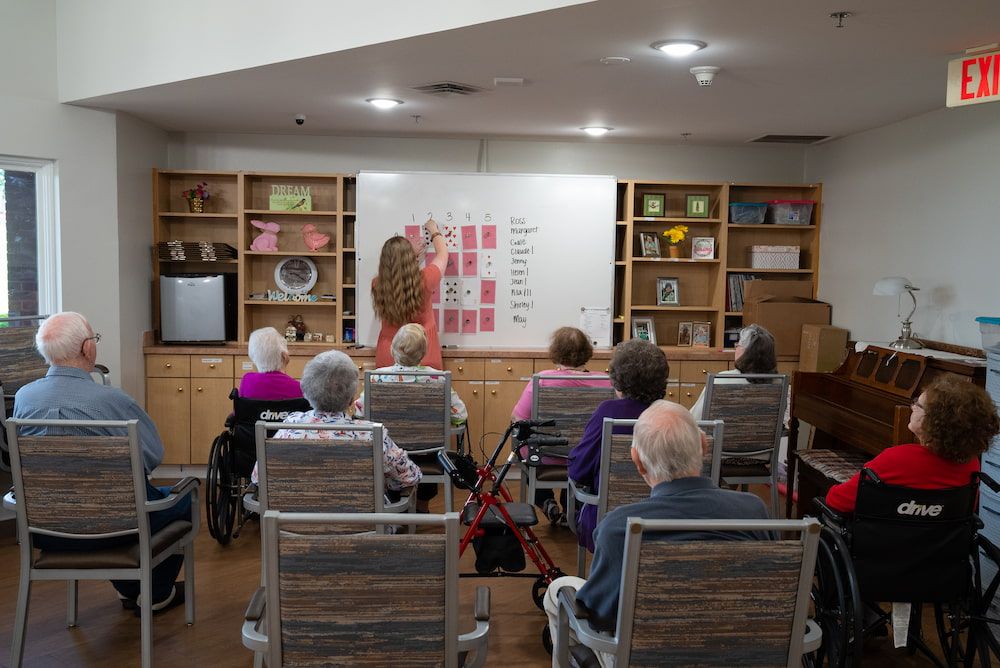Assisted Living vs. Independent Living
The senior living industry is massive, complex, and can even be a little difficult to navigate.
Deciding to move into a senior living community is a life-changing decision. You want to take the time to familiarize yourself with the industry and your choices.
The last couple of years have posed many challenges in the senior living industry, and because of progressive and innovative changes, the industry is better than ever.
Many assisted living and independent living communities are adding renovations and updates including improvements to upscale amenities, updating health and safety procedures, and focusing on wellness with innovative fitness classes, delicious healthy culinary choices, outdoor spaces, and mental health support with yoga and meditation classes.
Choosing the best option for yourself or a loved one is critical.
Two of the most well-known and misunderstood options are assisted living and independent living.
If you’re unsure of what’s best for your preference and care needs, this article will answer questions that you need to understand the key differences and select the community that best fits your lifestyle.
What is Assisted Living?
Many older adults may not yet have significant health issues but need help managing their personal care and daily household responsibilities.
Assisted living communities are designed for aging adults who need assistance with activities of daily living (ADLs), such as bathing, dressing, toileting, medications and grooming.
Assisted living communities are the perfect solution for seniors who value their independence and want to continue to socialize and interact with like-minded peers in a safe,comfortable and enjoyable environment.
These communities also benefit family members who cannot provide consistent care for loved ones due to work, family responsibilities and other obligations.
Assisted living communities provide residents with a safe community-based environment with various choices of living options.
Who Can Benefit from Assisted Living?
Although moving to an assisted living community can feel overwhelming, this level of care may be the best decision for seniors who are experiencing:
- Loneliness and isolation
- Safety concerns from living alone
- Frequent falls and injuries
- Difficulty maintaining personal hygiene or getting to the bathroom
- Difficulty driving
- Difficulty remembering to take medications
- A lack of social opportunities
Assisted Living Services and Amenities
Assisted living communities provide personalized care plans, and residents also have access to a wonderful selection of services and amenities.
Many seniors and their families enjoy the premium services offered in assisted living communities:
- 24/7 professional care
- Delicious healthy meal options
- 24/7 on-site security and emergency personnel
- Daily help with grooming, toileting, bathing, and dressing
- Medication administration and management
- Health services
- Housekeeping services like cleaning and laundry
- Spacious dining rooms
- A maintenance-free lifestyle
- Personal laundry service
Having access to a variety of amenities is an essential part of enjoying retirement and assisted living communities fit the bill with:
- Planned events
- Walking trails
- Spacious activity rooms
- Game rooms
- Library
- Craft areas
- Social gathering spaces
- Beauty salon
- Church services and devotionals
- Outdoor gazebos, courtyards, and covered patios
- Fitness centers
- Health and wellness programs

The Cost of Assisted Living
According to Genworth’s 2021 Financial Cost of Care Survey, the average monthly cost for assisted living in the United States is $4500.
However, assisted living costs can vary dramatically depending on your city and state. Prices can even vary within the same city depending on the amenities and services offered.
To calculate the cost of assisted living in your area, enter your information here.
Luxury amenities such as spas, pools, or concierge services will cost significantly more. Make sure you prioritize wants, needs, and must-haves to meet your budget.
In addition to location, several other factors will impact the cost you pay for assisted living, including:
Level of Care
Many assisted living communities will evaluate new residents to determine how much help is needed for ADLs and the amount of time required by staff to help with daily care.
The amount of daily care needed for a resident is a factor that determines ones monthly rent rate. . For example, a resident who doesn’t require much help with personal care may pay less than someone who needs extensive assistance with bathing, toileting, or dressing.
Accommodation Selections
The living accommodations selected could also affect the cost you pay for assisted living.
Depending on the community, residents can choose from apartment-style living and private or shared living spaces. However, more extensive floor plans, number of rooms, and luxury amenities may significantly increase costs.
Pricing Structure
Some assisted living communities like Hearthside Senior Living have an all-inclusive pricing structure, meaning you’re charged a flat fee each month.
Your monthly rent includes meals, utilities, housekeeping, laundry, activities, cable, and more. This pricing model makes it easier for residents to budget and manage their finances, and the price doesn’t increase as the level of care needs changes.
However, “all-inclusive” varies among assisted living communities, so make sure you understand what’s included in your monthly fee.
In an “A la Carte” pricing structure, communities charge a flat monthly fee for rent or rent and meals. Additional services are charged separately and can typically be added or removed as your needs change.
Other pricing factors to consider:
- Is a deposit required? Is it refundable?
- Billing policies
- Financial assistance programs
- Is there a fee if you cancel a contract early?
Paying for Assisted Living
Paying for assisted living is a significant concern for seniors. The first step is creating a budget, determining the care level needed, and evaluating your finances.
Seniors have several different options for paying for assisted living, including:
- Medicare and Medicaid. It doesn’t cover the cost of assisted living, although medicare may pay for health care costs while in a community
- The Department of Veteran Affairs (VA). Veterans can use The VA Aid and Attendance benefit or The Veteran Directed Care program to help with the cost of medical care.
- Long-Term Care Insurance. It will usually cover assisted living and medical expenses.
What is Independent Living?
Independent living, or retirement communities, are communities designed for older adults, generally ages 55 and older.
Unlike residents in assisted living communities, independent living residents are self-sufficient and don’t require assistance with personal care.
Some senior living communities offer the convenience of having independent living and assisted living communities on the same campus.
This gives residents the option of starting out living independently and transitioning to assisted living to receive more care while remaining in the same community.
Independent living communities could include condos, villas, or apartment-style homes, and provide a maintenance-free lifestyle with beautiful living spaces, from beautiful two or three-bedroom apartments to spacious open floor plans, patios, balconies and garages.
Check out these gorgeous homes at Hearthside Senior Living Independent Retirement Community.
Independent living communities focus on providing retired seniors an active lifestyle that includes planned social and recreational activities that can be enjoyed with peers.
Who Can Benefit From Independent Living?
Retirees want to settle down and enjoy a carefree life. As a result, many want to downsize from large homes with land that require constant maintenance to smaller living spaces.
The following older adults will benefit the most in independent living communities:
- Health-conscious seniors looking for living options with a focus on senior wellness
- Socially active seniors
- Older adults who want to spend time with people who share similar interests and values
Independent Services and Amenities
Retirement is all about fun and relaxation.
Independent living communities offer residents an all-inclusive lifestyle with opportunities to enjoy hobbies and pursue new interests, all in one community.
Independent living communities include services that allow residents to enjoy a maintenance-free retirement.
- Social activities and outings
- Cleaning and laundry services
- 24-hour security
- Pest control
- Personal culinary meal plans
- Exterior home maintenance (windows, roof, gutters, downspouts, garage door)
- Interior home maintenance (plumbing, electrical, air conditioner, appliances, flooring, painting)
- Lawn and landscape services
Today’s seniors are healthier and living longer than ever! They’re looking for safe, socially active independent living communities that encourage health and wellness.
Independent living communities are often located near restaurants, shopping, and recreational activities.
Having access to a variety of amenities is a must! Thriving independent living communities offer various amenities for residents.
- Private clubhouse for entertaining with friends and family
- Planned activities and outings
- Spa and salon
- Dining rooms
- Church services and devotionals
- Library
- Activity rooms
- Volunteer opportunities
- Clubs and community boards
- Game rooms
- Outdoor living spaces like gazebos, gardens, and patios
- Fitness and wellness classes
- Intimate lounge areas
The Cost of Independent Living
Of course, amenities and services are essential. However, you want to make sure your new community fits your financial goals.
On average, the monthly cost for independent living in the United States can range anywhere from $1500 to $7000 per month. Genworth’s cost calculator tool can help you calculate the cost of independent living communities in your area.
Since independent living residents don’t require assistance with personal care or medical care, it’s not a significant pricing component.
As with assisted living, expenses will vary between states and even within communities in the same city. Independent living costs vary based on many factors, including:
Amenities and Services
Amenities and services are the most significant contributors to what you’ll pay for independent living.
Recreational and social activities are a major component of independent living, and your cost can skyrocket once you start adding services and amenities.
Luxury amenities and services are great, but they will dramatically increase your costs.
Communities with pools, concierge services, state-of-the-art fitness centers, and high-end living spaces will cost more each month than those without these features.

Type of Accommodations
You’ll have your choice of floor plans, the number of rooms, and the square footage of homes or apartments in an independent living community. Larger units will likely cost more.
In addition, extra features like garages, screened-in patios, porches, and high-end fixtures could also increase prices.
Pricing Structure & Fees
Many people overlook and are surprised to find that independent living communities have different price structures that can significantly affect what you pay.
Communities with an all-inclusive pricing structure have a monthly fee, including rent, lawn maintenance, housekeeping, security, utilities, meals, cable, and scheduled transportation.
In contrast, A la carte pricing structure requires residents to pay for specific services.
Services and fees that might increase costs and may not be included in a monthly price include:
- Extended dining services
- Moving fees
- Entrance fees
- Association fees
- One time deposits
- Pet care
- Special activities or events
- Personal services like laundry, dry cleaning, meal delivery, or haircuts
- Medical assistance
Paying for Independent Living
Although residents in assisted living communities typically have more insurance and federal options, there are other options for financing independent living.
- Long-term Care Insurance. It will help pay for some independent living costs. Speak with your insurance agent for guidance.
- Reverse Mortgages. Allows seniors 62 years of age or older to borrow cash against the equity in their home. Makes sure to research the specific requirements before taking out a reverse mortgage.
- Personal Income & Savings. Pension distributions, retirement accounts, social security benefits, and investments are excellent ways to pay for independent living expenses.

Making the Right Choice
The right choice is the community that fits your wishes. This should include the culture and values of the team, the campus look and feel, and the rent package that best fits your needs.
Choosing to move into senior living is a big decision.
Seniors often struggle with needing help with personal care, selling a family home, and moving away from long-time familiarity.
In addition, navigating the many senior living choices takes time, knowledge, and patience.
Take the time to honestly assess your personal needs and health before deciding if assisted living or independent living is your best bet. Also, don’t forget to connect with the community administrator. He or she is willing and ready to answer questions and help your family navigate the options..
Ask friends, family, church members, and your physician for recommendations.
Make a list of communities that meet your requirements and set up a virtual or in-person tour. Take a trusted friend or family member with you for a second opinion.
During your tour, ask questions and make a note of:
- Cleanliness of common areas, living spaces, and dining areas
- Are residents active and social?
- Is the staff friendly and engaging?
- Does the culture of the community fit with your lifestyle?
- Safety features like guard rails, ramps, sufficient lighting
- Social activities, amenities, and services that interest you
- Emergency features
- Availability of help with personal and medical care (especially for assisted living)
Many communities will allow you to schedule a meal, giving you an excellent opportunity to access the dining areas, quality of the food, and maybe even meet residents.
What’s Next?
The future looks bright for the senior living industry. Our aging population is growing, and senior living owners and operators are meeting the demand with premium living options.
Socially active seniors who need support with personal care will thrive in assisted living communities.
Retirees looking for a maintenance-free, low-stress retirement with abundant social activities are perfect for independent living.
You’re ready to begin an exciting new journey now that you know the difference between assisted living and independent living communities.
If you’re ready to make a move and want more detailed information, give one of Hearthside Senior Living team members a call or complete our contact form.
We’re looking forward to speaking with you!




